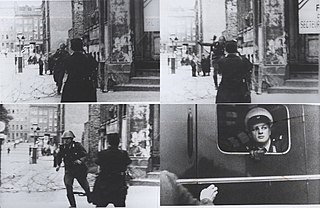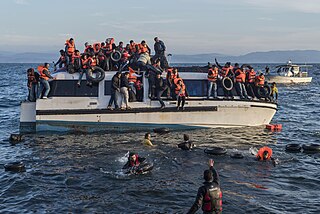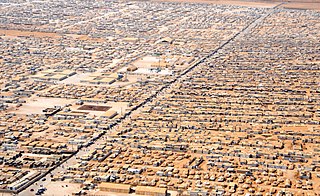Related Research Articles

A refugee, conventionally speaking, is a person who has lost the protection of their country of origin and who cannot or is unwilling to return there due to well-founded fear of persecution. Such a person may be called an asylum seeker until granted refugee status by the contracting state or the United Nations High Commissioner for Refugees (UNHCR) if they formally make a claim for asylum.
The right of return is a principle in international law which guarantees everyone's right of voluntary return to, or re-entry to, their country of origin or of citizenship. The right of return is part of the broader human rights concept freedom of movement and is also related to the legal concept of nationality. While many states afford their citizens the right of abode, the right of return is not restricted to citizenship or nationality in the formal sense. It allows stateless persons and for those born outside their country to return for the first time, so long as they have maintained a "genuine and effective link".

The Cyprus problem, also known as the Cyprus conflict, Cyprus issue, Cyprus dispute, or Cyprus question, is an ongoing dispute between the Greek Cypriot community which runs the Republic of Cyprus and the Turkish Cypriot community in the north where troops of the Republic of Turkey are deployed. The Cyprus dispute's causes stem from Greek and ethnic greek nationalist ideology and the Republic of Turkey and the ethnically Turkish peoples' desire for the partition of Cyprus as a means of safety and protection.

An internally displaced person (IDP) is someone who is forced to leave their home but who remains within their country's borders. They are often referred to as refugees, although they do not fall within the legal definitions of a refugee.

A refugee camp is a temporary settlement built to receive refugees and people in refugee-like situations. Refugee camps usually accommodate displaced people who have fled their home country, but camps are also made for internally displaced people. Usually, refugees seek asylum after they have escaped war in their home countries, but some camps also house environmental and economic migrants. Camps with over a hundred thousand people are common, but as of 2012, the average-sized camp housed around 11,400. They are usually built and run by a government, the United Nations, international organizations, or non-governmental organization. Unofficial refugee camps, such as Idomeni in Greece or the Calais jungle in France, are where refugees are largely left without the support of governments or international organizations.

Forced displacement is an involuntary or coerced movement of a person or people away from their home or home region. The UNHCR defines 'forced displacement' as follows: displaced "as a result of persecution, conflict, generalized violence or human rights violations".

Cyprus was part of the British Empire, under military occupation from 1914 to 1925, and a Crown colony from 1925 to 1960. Cyprus became an independent nation in 1960.
Loizidou v. Turkey is a landmark legal case regarding the rights of refugees wishing to return to their former homes and properties.
This article covers the civilian casualties and displacements that occurred between 1963 and 1975 – from the outbreak of the intercommunal fighting until the end of displacements following the Turkish invasion of Cyprus.

The Turkish invasion of Cyprus began on 20 July 1974 and progressed in two phases over the following month. Taking place upon a background of intercommunal violence between Greek and Turkish Cypriots, and in response to a Greek junta-sponsored Cypriot coup d'état five days earlier, it led to the Turkish capture and occupation of the northern part of the island.

Refugees of Iraq are Iraqi nationals who have fled Iraq due to war or persecution. Throughout 1980 until 2017, there were a large number of refugees fleeing Iraq and settling throughout the world, peaking with the Iraq War and continued until the end of the most recent War in Iraq (2013–2017). Precipitated by a series of conflicts including the Kurdish rebellions during the Iran–Iraq War, Iraq's Invasion of Kuwait (1990) and the Gulf War (1991), the subsequent sanctions against Iraq (1991–2003), culminating in the Iraq War and the subsequent War in Iraq (2013–2017), millions were forced by insecurity to flee their homes in Iraq. Like the majority of refugees worldwide, Iraqi refugees established themselves in urban areas in other countries rather than in refugee camps. In April 2007, there was an estimate of over four million Iraqi refugees around the world, including 1.9 million in Iraq, 2 million in neighboring Middle East countries, and around 200,000 in countries outside the Middle East. The United Nations High Commissioner for Refugees (UNHCR) has led the humanitarian efforts for Iraqi refugees. The Iraqi displacement of several million was the largest in the Middle East at the time, and was even larger than the number of Palestinians who were displaced in 1948 during the creation of the state of Israel.
Human rights in Cyprus are protected by the constitution of the Republic of Cyprus.
The United Nations High Commissioner for Refugees Representation in Cyprus is an office of the United Nations High Commissioner for Refugees (UNHCR) opened in August 1974 upon the request of the Government of Cyprus and the Secretary-General of the United Nations. UNHCR Representation in Cyprus was designated as Coordinator of the United Nations Humanitarian Assistance for Cyprus. UNHCR was also responsible upon the request of the Cyprus Government to examine applications for refugee status.
Apostolides v Orams is a landmark legal case decided in the European Court of Justice on 28 April 2009. It concerned the right for Greek Cypriot refugees to reclaim land in northern Cyprus, displaced after the Turkish invasion of Cyprus in 1974. The case determined that although Cyprus does not exercise effective control in northern Cyprus, cases decided in its courts are applicable through European Union law.
Cyprus v. Turkey (IV) (2001) is a case raised by Cyprus against Turkey in 1994 and decided on merits by the Grand Chamber of the European Court of Human Rights in 2001. It concerns the situation existing in Northern Cyprus after 1974 Turkish invasion of Cyprus and the de facto separation of the Mediterranean island.
Human rights in Northern Cyprus are protected by the constitution of Northern Cyprus. However, there have been reports of violations of the human rights of minorities, democratic freedom, freedom from discrimination, freedom from torture, freedom of movement, freedom of religion, freedom of speech, right to education, right to life, right to property, and the rights of displaced persons. The rights of Greek Cypriots displaced by the 1974 Turkish invasion of Cyprus, notably their rights to property and right of return, is one of the focal points of ongoing negotiations for the solution of the Cyprus question.
Refugees of the Syrian Civil War are citizens and permanent residents of Syria who have fled the country throughout the Syrian Civil War. The pre-war population of the Syrian Arab Republic was estimated at 22 million (2017), including permanent residents. Of that number, the United Nations (UN) identified 13.5 million (2016) as displaced persons, requiring humanitarian assistance. Of these, since the start of the Syrian Civil War in 2011 more than six million (2016) were internally displaced, and around five million (2016) had crossed into other countries, seeking asylum or placed in Syrian refugee camps worldwide. It is often described as one of the largest refugee crises in history.
Bloody Christmas, in Turkish Cypriot and Turkish historiography, refers to the resumption of intercommunal violence between the Greek Cypriots and the Turkish Cypriots during the Cyprus crisis of 1963–64, on the night of 20–21 December 1963 and the subsequent period of island-wide violence amounting to civil war. This initial episode of violence lasted until 31 December and was somewhat subdued with the start of peace talks at the London Conference, but outbursts of violence continued thereafter. The violence precipitated the end of Turkish Cypriot representation in the Republic of Cyprus.

Syrian refugee camp and shelters are temporary settlements built to receive internally displaced people and refugees of the Syrian Civil War. Of the estimated 7 million persons displaced within Syria, only a small minority live in camps or collective shelters. Similarly, of the 8 million refugees, only about 10 percent live in refugee camps, with the vast majority living in both urban and rural areas of neighboring countries. Beside Syrians, they include Iraqis, Palestinians, Kurds, Yazidis, individuals from Somalia, and a minority of those who fled the Yemeni and Sudanese civil wars.
A refugee crisis can refer to difficulties and dangerous situations in the reception of large groups of forcibly displaced persons. These could be either internally displaced, refugees, asylum seekers or any other huge groups of migrants.
References
- ↑ Christofias vetoes costly refugee law TheFreeLibrary.com
- ↑ Governmentand Politic
- 1 2 "Cyprus: failure of political settlement prevents the displaced from repossessing their properties". International Displacement Monitoring Centre. April 2005. Archived from the original on 12 August 2007. Retrieved 30 November 2019.
- ↑ "IDMC | Cyprus: Global IDP Figures". www.internal-displacement.org. Archived from the original on 12 October 2008.
- ↑ Williams Jr, Nick B. (20 March 1989). "Greek Cypriot Women, Turkish Police Scuffle : 3,000 Cross Border, Protest Island's Division; 9 Hurt, 50 Reported Arrested" – via LA Times.
- ↑ "European Court of Human Rights: Decision Against Turkey in Missing Persons Case Dating to 1974 Conflict with Cyprus". Library of Congress .
- ↑ "Case of Varnava and Others v. TURKEY (Applications nos. 16064/90, 16065/90, 16066/90, 16068/90, 16069/90, 16070/90, 16071/90, 16072/90 and 16073/90)".
- ↑ UNHCR Archived 2014-03-27 at the Wayback Machine UNHCR stopped help to displaced persons in Cyprus
- ↑ Abbott, Ryan (13 October 2014). "Property Spat Over Turk- Controlled Cyprus Fails". Courthouse News Service. Retrieved 15 October 2014.
- ↑ "TOUMAZOU et al v. REPUBLIC OF TURKEY et al". Justia. Retrieved 15 October 2014.
- ↑ "State Department issues Human Rights Report on Cyprus". philenews. Archived from the original on 21 April 2021. Retrieved 3 April 2020.



